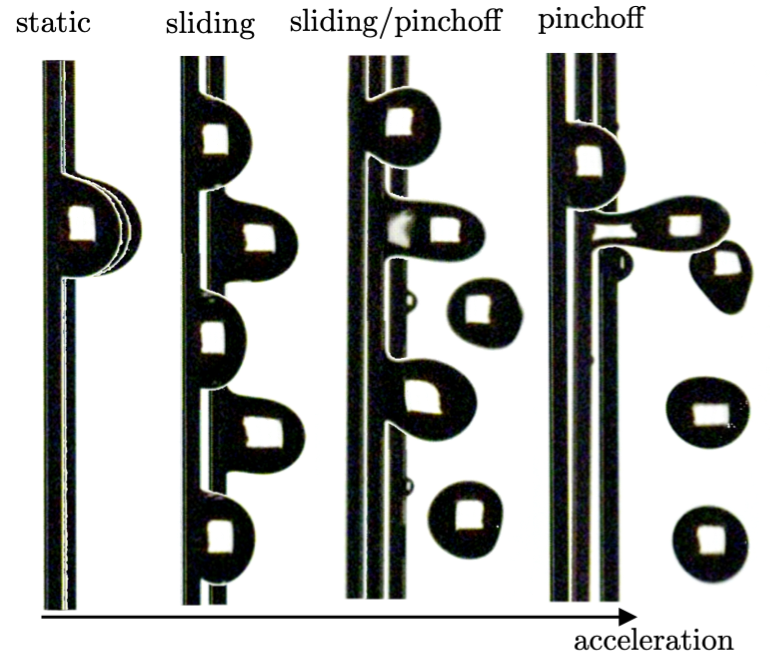
Drop dynamics on a vibrating vertical wire
Inspired by fog harvesting applications, we investigate droplet dynamics on a vibrating vertical wire. The drops remain static under low accelerations of vibration. By increasing the acceleration of the vibrations, the drop first slides down, and then pinches off for very high accelerations. Notably, the drop shows both sliding and pinchoff behavior in a "jumping" fashion for midrange accelerations between sliding and complete pinchoff.
Backflipping motion of bubbles colliding with a tilted surface
We uncover an interesting behavior by air bubbles of radii 0.6-0.7 mm that collide with inclined surfaces of up to 15 degrees, where they exhibit a backward motion upon collision. Notably, this "backflipping" motion of bubbles does not follow Newton's laws of collision. Our PIV experiments revealed a wake-induced circulation over the bubble that applies a lift force to the bubble.
Cleaning tilted surfaces using air bubbles under acoustic waves
We target sliding bubbles on a tilted surface coated with protein solutions with sonic acoustic waves. Our cleaning results indicate that the best cleaning outcome is around 100 Hz which is close to the capillary resonant frequency of the tested bubbles. We show that bubbles continuously oscillate as they slide over the surface. We explain how the oscillations induced by the pressure waves enhance the shear stress exerted over the surface by the bubbles.
Removing biofilms and bio-solutions from surfaces using air bubbles: effect of tilting angle
When a bubble impacts and slides along a tilted surface, it exerts a shear force on the surface. This shear force that comes from the lubrication film between the sliding bubble and the surface is noticeably large enough to remove contaminants such as bacteria or biological coatings from the surface. We show that at an angle of 22.5 degrees, bubbles clean surfaces with highest efficacy. This study provide a guideline for sustainable sanitization of soft surfaces such as fruits and vegetables.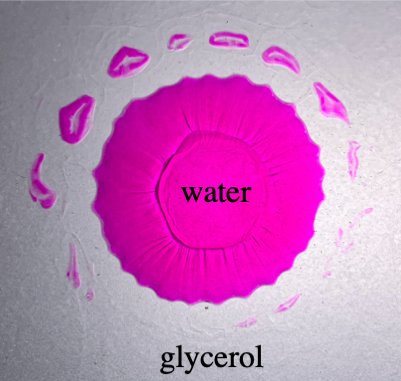
Marangoni-Buoyancy fingering of a spreading drop
When a drop of wwater in deposited on a bath of glycerol, the drop exhibits certain fingering patterns. These distinct patterns are the resutl of interactions between the destabilizing Buoyancy effects and the stabilizing Marangoni effects. This inward Marangoni flow from glycerol to water results in formation of a deeper pool in the center of the drop.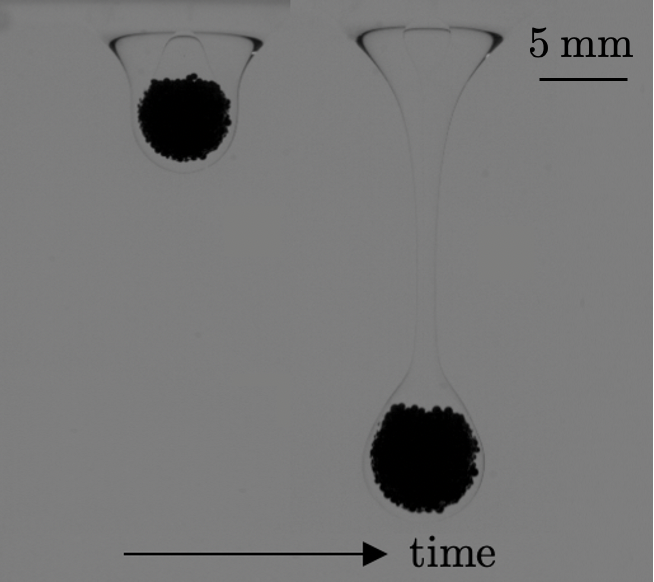
Gravity induced double encapsulation
Droplets coated with a protective armor of particles are relevant in the stabilization of emulsions. Here, we consider a setup that is comprised of a stratified system of three different layers of fluid with two immiscible interfaces: water-Iso Propanol Alcohol mixture, silicone oil, and water. When negatively buoyant particles are added to the system, they self-assemble into rafts on the water-IPA and oil interface. As the size of the raft increases, the gravity body force makes the raft unstable which leads to the encapsulation of water-IPA and the formation of armored droplets in the oil layer. These armored droplets sink down in the oil until they approach the oil-water interface. In this study, we focus on the hydrodynamic interactions of the water-IPA armored drop with the oil-water interface. Two distinct behaviors are exhibited by different drops: rupture or pinch-off.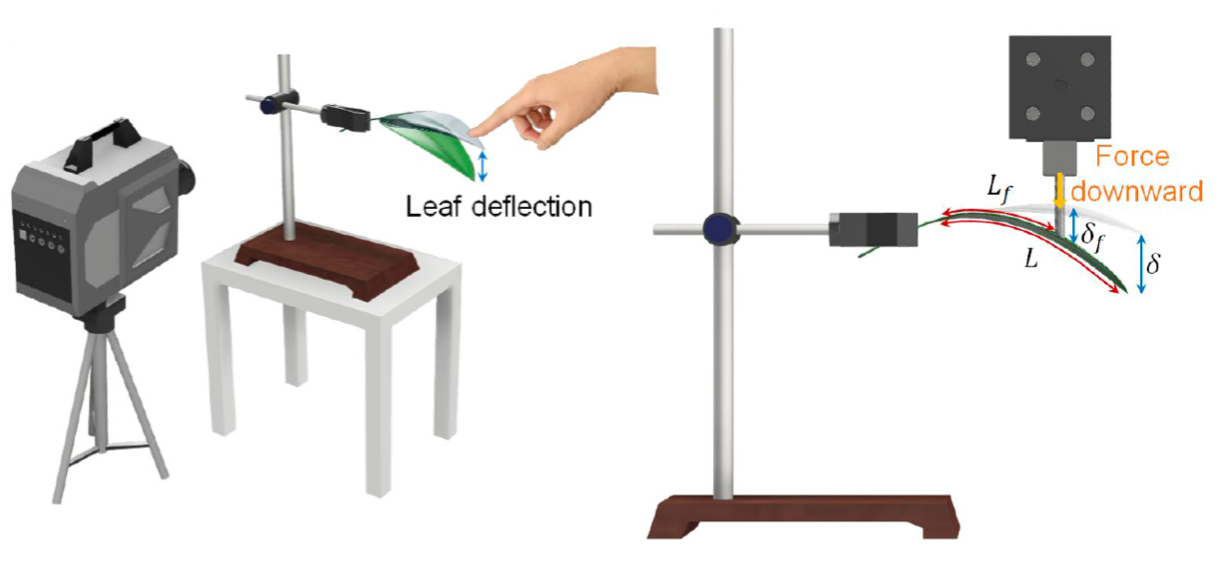
Fluttering leaves to quantify leaf's stiffness
Leaves are constantly deforming and vibrating from exposure to blowing wind or impacting raindrops. In this study, we quantified how material properties (e.g., elasticity and size) of a leaf correlate with its fluttering motion. Specifically, the complex response of a peace lily (Spathiphyllum wallisii) leaf upon a gentle hand strike at the tip of the lamina was decomposed into several degree-of-freedom modes of bending and torsion. Our findings support the investigation of leaf elasticity and size as indicators of leaf rigidity and overall plant performance under water stress.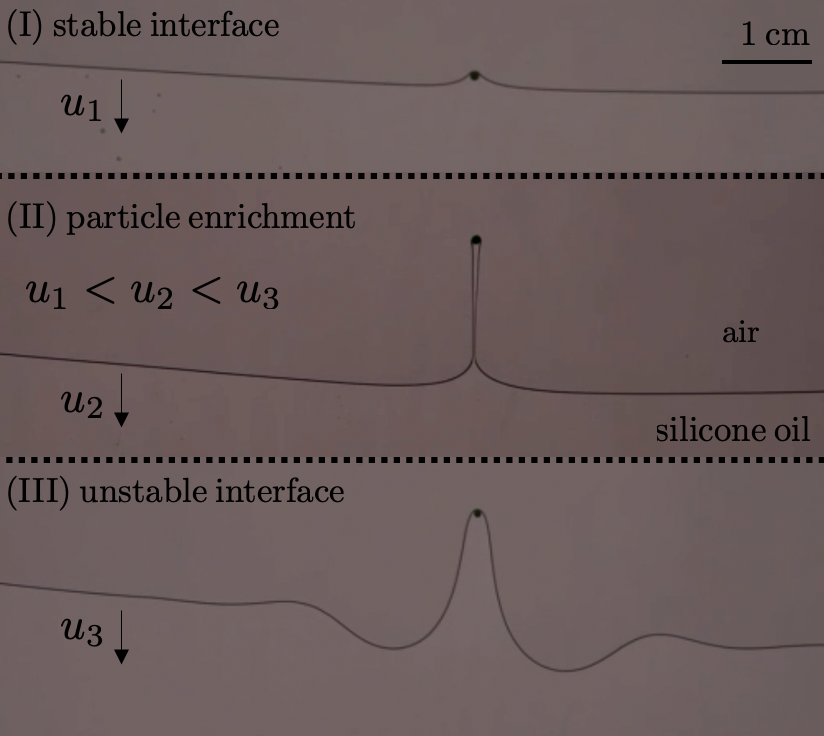
Particle enrichment on a receding fluid interface
We investigate the drainage of a suspension of non-colloidal particles from an immiscible fluid inside a vertical Hele-Shaw cell with a gap less than twice the nominal particle size. We find that particles in this case move slower than the draining mixture and eventually accumulate on the receding interface. The particle enrichment can cause an interfacial instability reminiscent of the classical Saffman-Taylor instability. However, the patterns observed in the present study are distinct from the classical viscous fingering patterns. While particle enrichment can be enhanced by the effects of particle-particle interaction, we show that the instability can also occur in case of a single particle for a narrower range of parameters.
Droplet under forcing by wind and gravity
Partially wetting drops are ubiquitous in nature and industry. In many cases such as rain drops on windows, droplets are subject to combined effects of gravity and wind forcing. Stability of water drops under forcing by wind and gravity is relevant to aircraft icing, heat exchangers, and fuel cells. Recent studies by Schmucker and White (2012) demonstrate a sharp transition in the trend of critical wind speed for droplet depinning from any inclined surface as a function of droplet size. To investigate what marks this self similar behavior, we conduct additional experiments of water drops on an inclined aluminum surface subject to forcing by wind. We find that the transition coincides with the onset of depinning for the advancing contact line. Inspired by this observation, we develop a mathematical model to rationalize the original experimental results of Schmucker and White.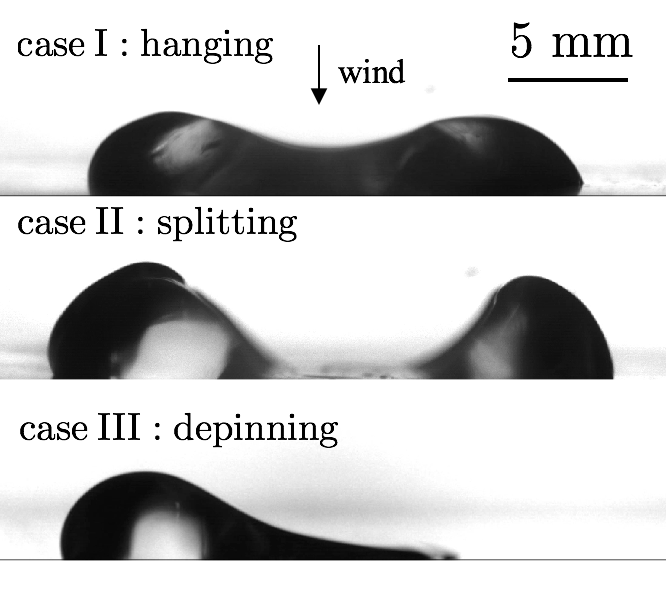
Droplet in a stagnation point flow
Inspired by droplet in the wake, we simplify the applied air flow and investigate partially wetting water droplets subject to a high speed jet of air blowing perpendicular to the substrate. In addition to droplet splitting at critical jet velocities, we observe depinning of the droplet onto one side when the jet is applied at a small distance from the initial centre of the droplet. Parallel to systematic experiments, we develop a mathematical model to compute the coupled evolution of the droplet and an idealised stagnation-point flow. Our simplified lubrication model, which incorporates the Prandtl boundary layer theory, yields a criterion for the critical jet velocity as well as the time-scale of the droplet breakup in qualitative agreement with the experiments. Finally, we posit different droplet behaviors by considering the capillary pressure inside the droplet.
Particle band viscous fingering
We present experiments and theory for viscous fingering of a suspension of non-colloidal particles undergoing radial flow in a Hele-Shaw cell. As the suspension displaces air, shear-induced migration causes particles to move faster than the average suspension velocity and to accumulate on the suspension-air interface. The resultant particle accumulation generates a pattern in which low-concentration, low-viscosity suspension displaces high-concentration, high-viscosity suspension and is unstable due to the classic Saffman-Taylor instability mechanism. While the destabilising mechanism is well-understood, what remains unknown is the stabilising mechanism that suppresses fine fingers characteristic of miscible fingering. In this work, we demonstrate how the stable suspension-air interface interacts with the unstable miscible interface to set the critical wavelength. We present a linear stability analysis for the time-dependent radial flow and show that the wavenumber predicted by the analysis is in good agreement with parametric experiments investigating the effect of suspension concentration and gap thickness of the Hele-Shaw cell.